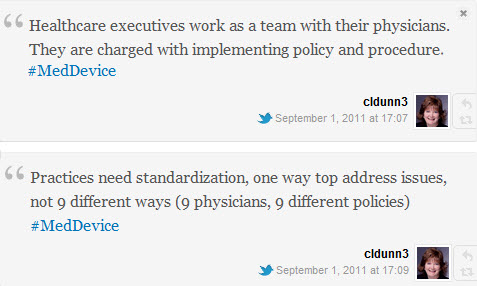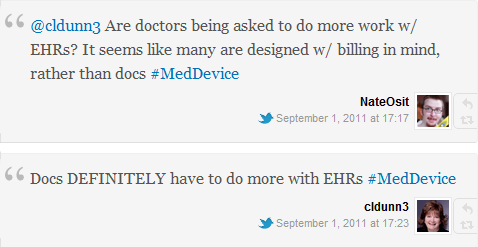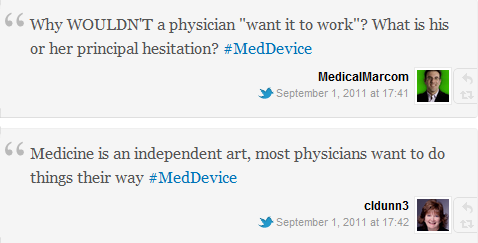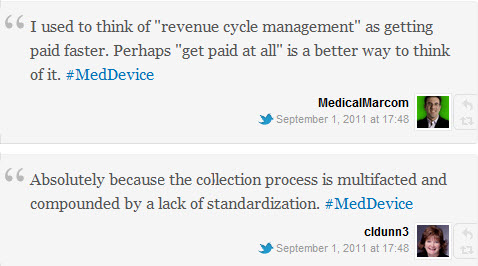 5 min reading time
5 min reading timeIf you’re marketing medical devices, be sure you understand your physician customers’ pain points.
And there are lots of them! (Pain points, that is.)
Today’s #MedDevice guest, Cindy Dunn, specializes in pain management. She’s a Practice Management Specialist for the Medical Group Management Association. She sees – and alleviates – physicians’ pain (EHR implementations, revenue cycle management; more) all the time.
Joe Hage: Delighted to have you here, Cindy. I recently interviewed @hjluks (Dr. Luks WON’T See You Now, Unless …) and he doesn’t want to hear from you! 🙂
Cindy Dunn: I could help Dr. Luks! Physicians need to see patients and support operational leadership but Dr. Luks does not need to lead the effort.
Joe Hage: So Dr. Luks will see patients and you’ll take care of the rest with the office? How much face time do you need to help Howard? Is “the doctor doesn’t have time for this” your biggest obstacle?
Cindy Dunn:
Joe Hage: Who is your typical customer?
Cindy Dunn: Physician practice or an IDN, the integrated delivery network (hospital now employing physicians). I am typically invited in by the CEO, COO, Executive Director, Administrator or Physician.
Joe Hage: So the doctor DOES have time for you!
Cindy Dunn: Absolutely!
Physicians are unhappy with the amount of work they do and the declining reimbursement environment they face today. The docs work hard and the fee schedules continue to decrease.
Utilizing technology is extremely important to assist practices with efficiency.
Joe Hage: $1 out of four … so the practice is targeting a 25% margin after all expenses and all labor is paid?
Cindy Dunn: Oh no, we wish that were the margin!
The 25% is the percentage of the patient’s bill that needs to come from co-pays, deductibles, and co-insurance. The other 75% includes Medicare, Medicaid, etc … if you collect it!
Bottom line, practices need to be prepared/trained to collect what they are required to collect at the time of service.
Nate Osit:
Cindy Dunn: Training and implemetation are key to the success of the use of the EHR. Successful EHR implementation is directly impacted by physician leadership (or lack thereof).
It makes no difference if you or I know how to use the EHR.
Physician leaders must hold their colleagues responsible for committing to training and supporting the EHR.
They must know how the software functions, different orders are placed in different areas, if not correctly placed staff must go back and re-enter the information. Staff must be trained so they understand the functionality and utilize this tool to make them more efficient.
However every practice utilizes the same software differently. Determining what you want and need to the EHR to do for you is essential before the practice purchases the EHR.
Joe Hage:
Cindy Dunn: Each practice needs to determine their “pain points,” what can the technology help me do better?
For some it is decreased labor, increased collections, meeting meaningful use criteria. Every practice is different.
Joe Hage: Take us through a typical physician office assessment you’d conduct.
Cindy Dunn: First I clarify scope, revenue cycle, practice operations, and address upfront questions. I send written proposal outlining scope to practice.
They review, we tweak. Once signed I set up dates with practice contact.
We’ve been doing more and more workflow and process assessments. I send out a practice process assessment for the staff and providers to complete. This assessment helps me focus on the problem areas.
Once onsite I meet one on one with the physicians, management, and staff. I sit with the employees in the different areas and note what they are doing, I ask MANY questions (WHY is a big one).
Joe Hage:
Cindy Dunn: When a practice has to do the same functions nine different ways there is a great deal of waste.
For example, surgeons may say “I want to do surgery and I want the staff to collect the patient’s payment.” BUT before the staff can collect the surgeon says “I have an opening tomorrow, put them in.”
The staff doesn’t collect! And once the procedure is complete it is difficult to collect and the AR (accounts receivable) grows.
It’s a mixed message, “collect but don’t follow the rules regarding collection, just put the patient in the slot.”
Joe Hage:
Joe Hage: Does the office need someone to focus exclusively on collecting? Do most have this function? Or is it too expensive because you add another headcount?
Cindy Dunn: They do and have business office employees assigned to this function. Practices must change from a back office collection strategy to a front office strategy.
Joe Hage: Time’s running short. Share with us a recent “success story” you’ve had.
Cindy Dunn: Fortunate to say I have had many successes, operational leaders and physicians want their business to run smoothly.
Success means that the practice has focused on training and communication before undertaking any change.
My biggest successes come from physicians becoming involved in the leadership of their business.
Cindy Dunn offers clients practical and efficient solutions utilizing technology in business and clinical management. She understands workflow processes and assists practices with the operational redesign using technology.
…
>>> Click to review the archive of #MedDevice chats you missed! <<<
Join the Medical Devices Group on LinkedIn to network and grow your business. #MedDevice is held most Wednesdays, 4 p.m. EST. We interview the medical device industry’s best minds and cover issues including sales, reimbursement, distribution, EMRs/HIT, regulations, and Marketing Medical Devices.













